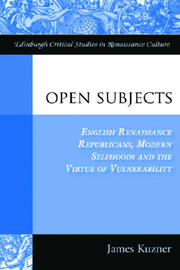Book contents
- Frontmatter
- Contents
- Acknowledgements
- Series Editor's Preface
- Introduction: Vulnerable Crests of Renaissance Selves
- 1 Legacies of Republicanism, Histories of the Self
- 2 ‘Without Respect of Utility’: Precarious Life and the Politics of Edmund Spenser's Legend of Friendship
- 3 Unbuilding the City: Coriolanus, Titus Andronicus and the Forms of Openness
- 4 ‘That Transubstantiall solacisme’: Andrew Marvell, Linguistic Vulnerability and the Space of the Subject
- 5 Habermas Goes to Hell: Pleasure, Public Reason and the Republicanism of Paradise Lost
- Epilogue: The Futures of Open Subjects
- Index
Introduction: Vulnerable Crests of Renaissance Selves
Published online by Cambridge University Press: 12 September 2012
- Frontmatter
- Contents
- Acknowledgements
- Series Editor's Preface
- Introduction: Vulnerable Crests of Renaissance Selves
- 1 Legacies of Republicanism, Histories of the Self
- 2 ‘Without Respect of Utility’: Precarious Life and the Politics of Edmund Spenser's Legend of Friendship
- 3 Unbuilding the City: Coriolanus, Titus Andronicus and the Forms of Openness
- 4 ‘That Transubstantiall solacisme’: Andrew Marvell, Linguistic Vulnerability and the Space of the Subject
- 5 Habermas Goes to Hell: Pleasure, Public Reason and the Republicanism of Paradise Lost
- Epilogue: The Futures of Open Subjects
- Index
Summary
One of the first recorded English uses of ‘vulnerable’ comes from the mouth of Macbeth, in a famously erroneous claim to be invulnerable: ‘Let fall thy blade on vulnerable crests,’ he tells Macduff, ‘I bear a charmed life, which must not yield / To one of woman born’ (V, vii, 40–2). Here we see the culmination of Macbeth's extreme, alterable and now fatal reactions to his status as a mortal being. We have seen him strive to eliminate competitors for the throne, a striving that, after Duncan's death, gives rise to overpowering paranoia – a sense of utter exposure, of fatal trespass threatened upon his person. Macbeth enters a state in which ‘every noise appalls’ him; he becomes a being plunged into ‘restless ecstasy’, undone by the living and the dead, believing that ‘every minute’ of Banquo's very existence ‘thrusts / Against my near'st of life’ (II, ii, 56; III, ii, 22; III, i, 18–19). The whole of Macbeth's world – every image, every word, the mere fact that he occupies the same social field as Banquo – seems to expose him and to send him headlong toward his demise. Later in the play, Macbeth is mistakenly assured of his invincibility by an apparition (to whose mollifying words he, as with so much else, proves unhealthily susceptible). Suddenly, Macbeth becomes indifferent to the dangers that had overwhelmed him just moments before.
- Type
- Chapter
- Information
- Open SubjectsEnglish Renaissance Republicans Modern Selfhoods and the Virtue of Vulnerability, pp. 1 - 9Publisher: Edinburgh University PressPrint publication year: 2011



